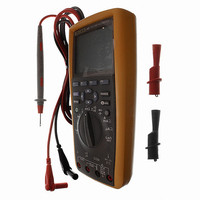FLUKE-289 Fluke Electronics, FLUKE-289 Datasheet - Page 52

FLUKE-289
Manufacturer Part Number
FLUKE-289
Description
DMM TRUE RMS 50000CNT W/BCKLGHT
Manufacturer
Fluke Electronics
Series
28xr
Type
Digital (DMM)r
Datasheet
1.FLUKE-289.pdf
(88 pages)
Specifications of FLUKE-289
Includes
Battery, Clips, Test Leads
Style
Handheld
Display Digits
4.5
Display Type
LCD, Bar Graph
Display Count
50000
Function
Voltage, Current, Resistance, Capacitance, Temperature, Frequency
Functions, Extra
Continuity, dB
Features
Data Logging, Hold, Memory, Min/Max/Ave
Ranging
Auto/Manual
Response
True RMS
Lead Free Status / RoHS Status
Not applicable / RoHS non-compliant
Other names
289
614-1062
614-1062
287/289
Users Manual
The following are tips for current measurements:
A current meter drops a small voltage across itself, which might
affect circuit operation. You can calculate this burden voltage
using the values listed in the specifications under Burden Voltage
(A, mA, A).
The Meter’s current functions have a number of modes which
provide more details about a current signal. Pressing the softkey
labeled Menu opens a menu of items that can be used to modify
the basic current measurement. Refer to the appropriate section
in this manual to learn more about each menu item.
To clear all modes and return to the basic ac or dc current
measurement, press the softkey labeled Menu. Move the menu
selector to the item labeled AC,DC. Press the softkey labeled AC
to clear all functions and modes and make basic ac current
measurements, or DC for basic dc current measurements.
Measuring Frequency
Frequency is the number of cycles a signal completes each
second. The meter measures the frequency of a voltage or
current signal by counting the number of times the signal crosses
a threshold level within a specified period of time.
42
Placing the probes across (in parallel with) a
powered circuit when a lead is plugged into a
current terminal can damage the circuit you are
testing and blow the Meter's fuse. This can happen
because the resistance through the Meter's current
terminals is very low, so the Meter acts like a short
circuit.
W
Caution
Figure 23 highlights the functions that allow frequency
measurements.
The Meter autoranges to one of five frequency ranges:
99.999 Hz, 999.99 Hz, 9.9999 kHz, 99.999 kHz, and 999.99 kHz.
Figure 24 shows a typical frequency display. Pressing R
controls the input range of the primary function (volts or amps)
and not the frequency range.
To measure frequency, rotate the switch to one of the primary
functions allowing frequency measurements highlighted in
Figure 23. Press the softkey labeled Menu and move the menu
Figure 23. Functions Allowing Frequency
Measurement
est21.eps










